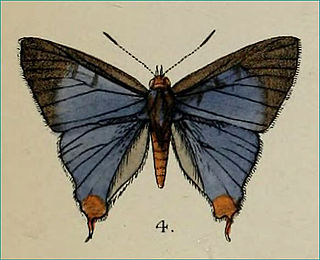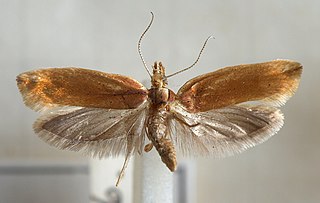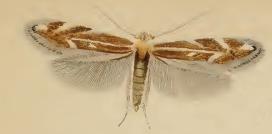
Appias lalage, the spot puffin, is a small butterfly of the family Pieridae, that is, the yellows and whites, which is found in India, Indochina and Hainan.

Cigaritis abnormis, the abnormal silverline, is a species of lycaenid or blue butterfly found in south India and Pakistan.

Ypsolopha ustella, the variable ypsolopha moth, is a moth of the family Ypsolophidae. It is found in most of Europe and is also present in North America.

Bucculatrix maritima is a species of moth of the family Bucculatricidae. It is found in most of Europe, Russia and Japan. It was first described in 1851 by Henry Tibbats Stainton.
Anarsia antisaris is a moth of the family Gelechiidae. It was described by Edward Meyrick in 1913. It is found in South Africa.
Rhopalosetia is a monotypic moth genus in the family Copromorphidae. Its only species, Rhopalosetia phlyctaenopa, is found in French Guiana. Both the genus and species were first described by Edward Meyrick in 1926.
Idiophantis chiridota is a moth of the family Gelechiidae. It was described by Edward Meyrick in 1914. It is found in Sri Lanka, Thailand, on the Sunda Islands and Fiji.
Anacampsis conistica is a moth of the family Gelechiidae. It was described by Thomas de Grey, 6th Baron Walsingham, in 1910. It is found in Mexico.
Anacampsis rhabdodes is a moth of the family Gelechiidae. It was described by Thomas de Grey in 1910. It is found in Mexico (Tabasco).
Aristotelia penicillata is a moth of the family Gelechiidae. It was described by Walsingham in 1897. It is found in West Indies, where it has been recorded from Haiti.
Ornativalva heligmatodes is a moth of the family Gelechiidae. It was described by Walsingham in 1904. It is found in Algeria and Tunisia.
Stenoma cana is a moth of the family Depressariidae. It is found in Brazil (Amazonas), Peru and French Guiana.
Stenoma recondita is a species of moth of the family Depressariidae. It is found in Guyana.
Stenoma staudingerana is a moth of the family Depressariidae. It is found in the Colombia, French Guiana and Pará, Brazil.
Falculina lepidota is a moth of the family Depressariidae. It is found in French Guiana.
Stenoma symphonica is a moth of the family Depressariidae. It is found in French Guiana and Panama.
Antaeotricha erotica is a moth of the family Depressariidae. It is found in French Guiana.
Antaeotricha orthriopa is a species of moth in the family Depressariidae. It was described by Edward Meyrick in 1925. It is found in Brazil.
Antaeotricha tornogramma is a moth in the family Depressariidae. It was described by Edward Meyrick in 1925. It is found in Brazil.
Stenoma ptychobathra is a moth in the family Depressariidae. It was described by Edward Meyrick in 1930. It is found in Brazil.


